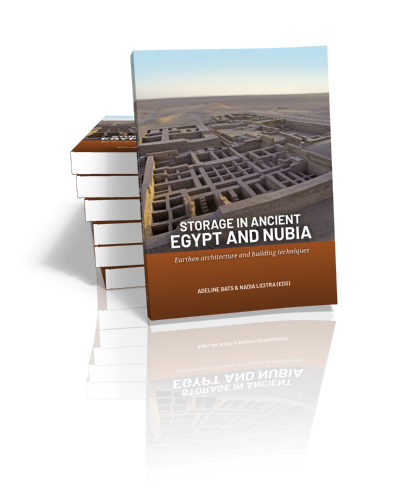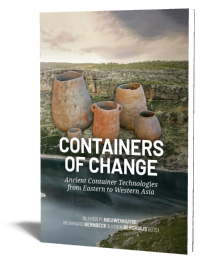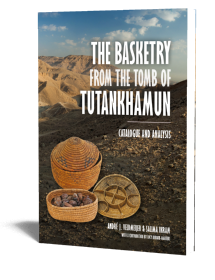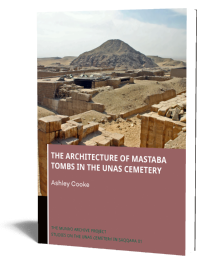Storage in Ancient Egypt and Nubia
Earthen architecture and building techniques
Edited by Adeline Bats & Nadia Licitra | 2023

Storage in Ancient Egypt and Nubia
Earthen architecture and building techniques
Edited by Adeline Bats & Nadia Licitra | 2023
Paperback ISBN: 9789464262230 | Hardback ISBN: 9789464262247 | Imprint: Sidestone Press | Format: 210x280mm | 196 pp. | Language: English & French | 14 illus. (bw) | 66 illus. (fc) | Keywords: storage buildings; earthen architecture; archaeology; building materials; ancient Egypt; ancient Nubia; ethnoarchaeology; experimental archaeology; food preservation; grain storage | download cover | DOI: 10.59641/o29221ra
Read online 948 times
- Digital & Online access
-
Buy via Sidestone (EU & UK)
-
Buy via our Distributors (WORLD)
For non-EU or UK destinations you can buy our books via our international distributors. Although prices may vary this will ensure speedy delivery and reduction in shipping costs or import tax. But you can also order with us directly via the module above.
UK international distributor
USA international distributor
-
Bookinfo
Paperback ISBN: 9789464262230 | Hardback ISBN: 9789464262247 | Imprint: Sidestone Press | Format: 210x280mm | 196 pp. | Language: English & French | 14 illus. (bw) | 66 illus. (fc) | Keywords: storage buildings; earthen architecture; archaeology; building materials; ancient Egypt; ancient Nubia; ethnoarchaeology; experimental archaeology; food preservation; grain storage | download cover | DOI: 10.59641/o29221ra
Read online 948 times

We will plant a tree for each order containing a paperback or hardback book via OneTreePlanted.org.
In 2020 and 2021 the Research Group on Storage in Ancient Egypt and Sudan organised two online workshops focusing on earthen storage buildings in ancient Egypt and Nubia. Following these two meetings, the nine contributions of this volume present often unpublished case studies (from the IVth millennium BCE to the Greco-Roman Period), as well as issues and perspectives of current research. They are authored by archaeologists working in Egypt, Sudan and Western Africa as well as architects specialised in earthen architecture.
The interdisciplinary approach adopted to investigate storage strategies along the ancient Nile Valley effectively address the subject’s complexity and the socioeconomic issues involved, which not only pertain to the ancient world but are also relevant to modern-day societies. Throughout the volume, functional and technical analysis of the architectural and archaeological remains helps understand how specific layouts, building materials and techniques were employed in the past to create suitable conditions for short-, medium- and long-term storage.
Ethnographic and ethnoarchaeological comparisons with West African vernacular traditions are used as a fruitful line of research for better understand of building practices, storage strategies and possible volumes of archaeological remains. Furthermore, extending the scope of the research to other geographical areas shows how different human groups may have used similar responses to overcome similar technical problems. Ancient and traditional practices and know-how, on the other hand, proved effective in a contemporary onion storehouse project in Senegal to find sustainable, low-cost solutions to protection and development of local products.
The volume also include the preliminary results of an experimental archaeology project which led to the construction of a mud-brick silo – according to ancient Egyptian techniques – and further ensiling. The issue is highly topical since these ancient earthen facilities offer valuable information for the current debates on sustainable strategies for foodstuff storage.
Storage buildings in ancient Egypt and Nubia. Issues and perspectives
Adeline Bats, Nadia Licitra
Pits, pots and silos: Storage facilities at the Predynastic and early pharaonic settlement of Elkab
Wouter Claes, Stan Hendrickx, Elizabeth Hart
Les structures circulaires de stockage à Karnak aux XIIe et XIIIe dynasties
Marie Millet
Le bâtiment BAT 603 de Kôm el-Nogous/Plinthine : un édifice de stockage polyvalent de l’époque saïto-perse ?
Bérangère Redon
Le thêsauros ptolémaïque de Tebtynis (Fayoum)
Gisèle Hadji-Minaglou
Un thêsauros à Bouto. Architecture et organisation d’un bâtiment de stockage dans le Delta nord-occidental à l’époque impériale
Loïc Mazou
Variabilité des dispositifs de stockage en Afrique de l’Ouest : approches ethnoarchéologiques
Anne Mayor, Thomas Pelmoine
Intérêts croisés des échanges transdisciplinaires entre architecture, archéologie et développement durable
David Gandreau, Thierry Joffroy, Philippe Garnier, Nuria Sanchez Muñoz, Majid Hajmirbaba, Mauricio Corba Barreto
The Egyptian mud-brick silo. Technical and functional analysis of a grain storage device
Adeline Bats, Nadia Licitra, Thierry Joffroy, Bastien Lamouroux, Aurélie Feuillas, Julie Depaux
Dr. Adeline Bats
Adeline Bats holds a PhD in Egyptology from the University of Paris Sorbonne and is an associate researcher at the UMR 8167 Orient & Mediterranean. She has been field archaeologist of the archaeological mission of Ayn Sukhna (Ifao/UMR 8167) since 2014 and is also a member of the archaeological mission of Ouadi el-Jarf (Ifao/UMR 8167) and the Swiss-Franco-Sudanese mission of Kerma-Dukki Gel. Her PhD thesis, defended in 2019 under the direction of Pierre Tallet and Juan Carlos Moreno García, focuses on the role played by cereals in the Pharaonic society, in human and animal nutrition, and as means of payment. Along with Nadia Licitra, she founded in 2019 the Research Group on Storage in Ancient Egypt and Sudan.
Dr. Nadia Licitra
Nadia Licitra is an archaeologist, post-doc fellow of CRAterre (AE&CC/ENSAG/UGA) and associated member of UMR 8167 Orient & Méditerranée of CNRS. She obtained her PhD degree in Egyptology in 2014 (Paris-Sorbonne University) and has been Head of the mission of the Treasury of Shabaqo in Karnak (UMR 8167/CFEETK) since 2008. She has participated and continues to be involved in several archaeological missions in Italy, Egypt and Sudan. Her research focuses mainly on building techniques and materials of Nile Valley earthen architecture and storage architecture. Along with Adeline Bats, she founded in 2019 the Research Group on Storage in Ancient Egypt and Sudan.
Abstract:
In 2020 and 2021 the Research Group on Storage in Ancient Egypt and Sudan organised two online workshops focusing on earthen storage buildings in ancient Egypt and Nubia. Following these two meetings, the nine contributions of this volume present often unpublished case studies (from the IVth millennium BCE to the Greco-Roman Period), as well as issues and perspectives of current research. They are authored by archaeologists working in Egypt, Sudan and Western Africa as well as architects specialised in earthen architecture.
The interdisciplinary approach adopted to investigate storage strategies along the ancient Nile Valley effectively address the subject’s complexity and the socioeconomic issues involved, which not only pertain to the ancient world but are also relevant to modern-day societies. Throughout the volume, functional and technical analysis of the architectural and archaeological remains helps understand how specific layouts, building materials and techniques were employed in the past to create suitable conditions for short-, medium- and long-term storage.
Ethnographic and ethnoarchaeological comparisons with West African vernacular traditions are used as a fruitful line of research for better understand of building practices, storage strategies and possible volumes of archaeological remains. Furthermore, extending the scope of the research to other geographical areas shows how different human groups may have used similar responses to overcome similar technical problems. Ancient and traditional practices and know-how, on the other hand, proved effective in a contemporary onion storehouse project in Senegal to find sustainable, low-cost solutions to protection and development of local products.
The volume also include the preliminary results of an experimental archaeology project which led to the construction of a mud-brick silo – according to ancient Egyptian techniques – and further ensiling. The issue is highly topical since these ancient earthen facilities offer valuable information for the current debates on sustainable strategies for foodstuff storage.
Contents
Storage buildings in ancient Egypt and Nubia. Issues and perspectives
Adeline Bats, Nadia Licitra
Pits, pots and silos: Storage facilities at the Predynastic and early pharaonic settlement of Elkab
Wouter Claes, Stan Hendrickx, Elizabeth Hart
Les structures circulaires de stockage à Karnak aux XIIe et XIIIe dynasties
Marie Millet
Le bâtiment BAT 603 de Kôm el-Nogous/Plinthine : un édifice de stockage polyvalent de l’époque saïto-perse ?
Bérangère Redon
Le thêsauros ptolémaïque de Tebtynis (Fayoum)
Gisèle Hadji-Minaglou
Un thêsauros à Bouto. Architecture et organisation d’un bâtiment de stockage dans le Delta nord-occidental à l’époque impériale
Loïc Mazou
Variabilité des dispositifs de stockage en Afrique de l’Ouest : approches ethnoarchéologiques
Anne Mayor, Thomas Pelmoine
Intérêts croisés des échanges transdisciplinaires entre architecture, archéologie et développement durable
David Gandreau, Thierry Joffroy, Philippe Garnier, Nuria Sanchez Muñoz, Majid Hajmirbaba, Mauricio Corba Barreto
The Egyptian mud-brick silo. Technical and functional analysis of a grain storage device
Adeline Bats, Nadia Licitra, Thierry Joffroy, Bastien Lamouroux, Aurélie Feuillas, Julie Depaux
Dr. Adeline Bats
Adeline Bats holds a PhD in Egyptology from the University of Paris Sorbonne and is an associate researcher at the UMR 8167 Orient & Mediterranean. She has been field archaeologist of the archaeological mission of Ayn Sukhna (Ifao/UMR 8167) since 2014 and is also a member of the archaeological mission of Ouadi el-Jarf (Ifao/UMR 8167) and the Swiss-Franco-Sudanese mission of Kerma-Dukki Gel. Her PhD thesis, defended in 2019 under the direction of Pierre Tallet and Juan Carlos Moreno García, focuses on the role played by cereals in the Pharaonic society, in human and animal nutrition, and as means of payment. Along with Nadia Licitra, she founded in 2019 the Research Group on Storage in Ancient Egypt and Sudan.
Dr. Nadia Licitra
Nadia Licitra is an archaeologist, post-doc fellow of CRAterre (AE&CC/ENSAG/UGA) and associated member of UMR 8167 Orient & Méditerranée of CNRS. She obtained her PhD degree in Egyptology in 2014 (Paris-Sorbonne University) and has been Head of the mission of the Treasury of Shabaqo in Karnak (UMR 8167/CFEETK) since 2008. She has participated and continues to be involved in several archaeological missions in Italy, Egypt and Sudan. Her research focuses mainly on building techniques and materials of Nile Valley earthen architecture and storage architecture. Along with Adeline Bats, she founded in 2019 the Research Group on Storage in Ancient Egypt and Sudan.
- Digital & Online access
-
Buy via Sidestone (EU & UK)
-
Buy via our Distributors (WORLD)
For non-EU or UK destinations you can buy our books via our international distributors. Although prices may vary this will ensure speedy delivery and reduction in shipping costs or import tax. But you can also order with us directly via the module above.
UK international distributor
USA international distributor
- Browse all books by subject
-
Search all books

We will plant a tree for each order containing a paperback or hardback book via OneTreePlanted.org.
You might also like:
© 2026 Sidestone Press KvK nr. 28114891 Privacy policy Sidestone Newsletter Terms and Conditions (Dutch)








